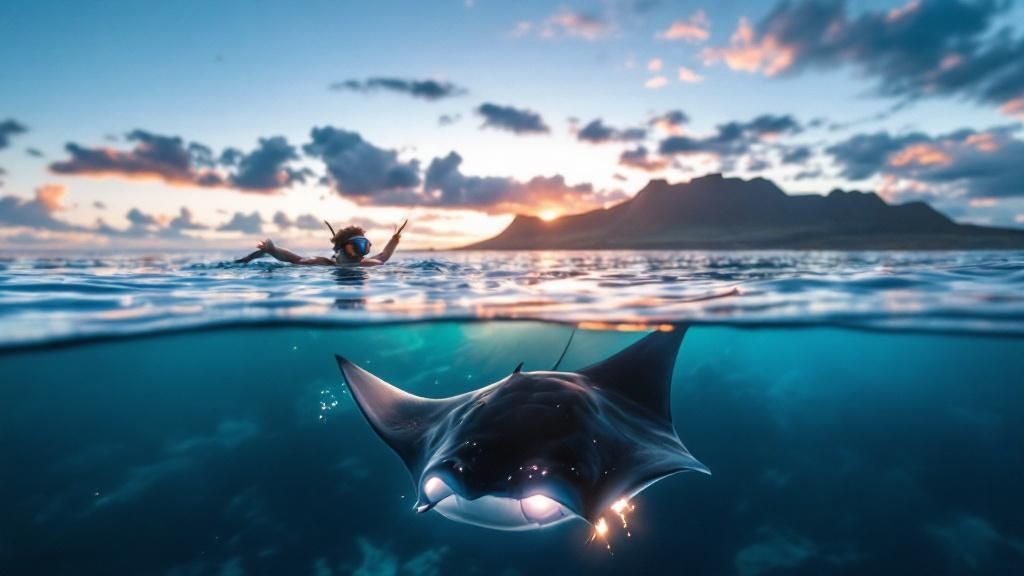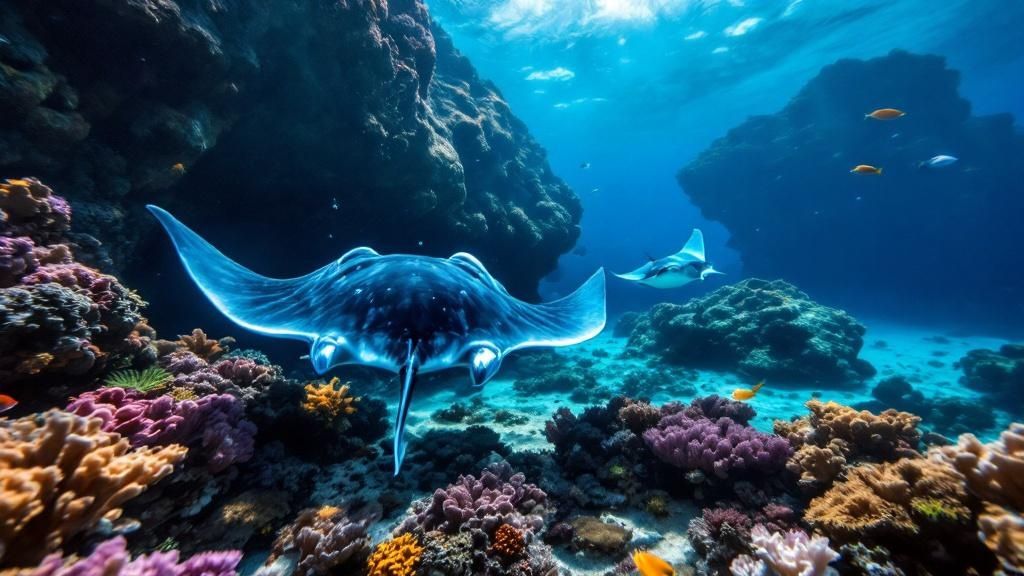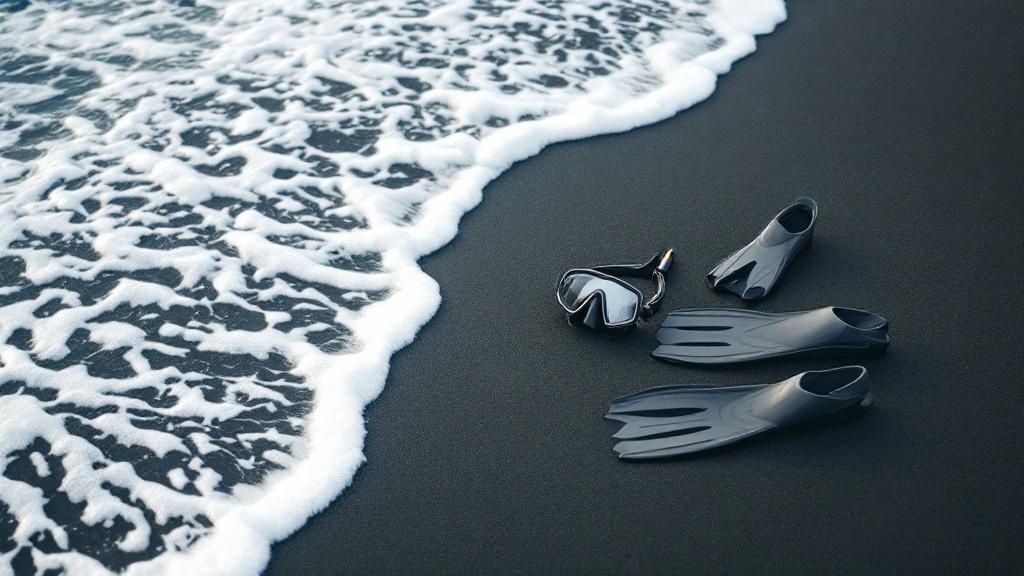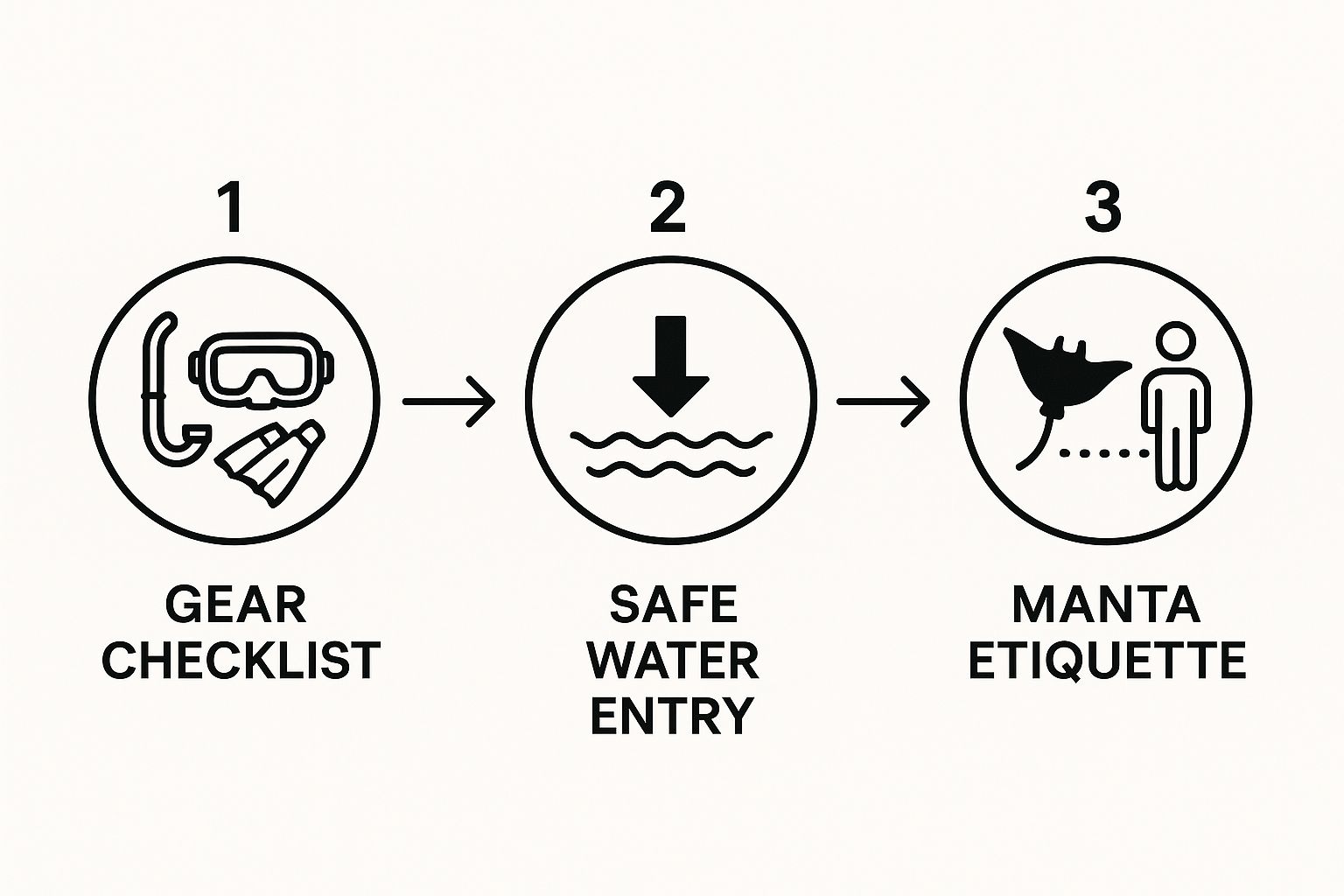Manta Ray Snorkel Big Island: Ultimate Guide & Best Spots
- Byron
- Jul 24
- 14 min read
Welcome to one of the most unforgettable underwater encounters you can have anywhere on the planet: the manta ray night snorkel right here on the Big Island of Hawai‘i. Think of this guide as your first step into an incredible, almost surreal adventure. This isn't just another tour; it's a profound connection with nature that people talk about for years to come.
Your Guide to the Manta Ray Night Snorkel
This guide is all about what it’s really like to float in the warm Pacific as these gentle giants glide just inches beneath you, lit up by powerful underwater lights. We're Manta Ray Night Snorkel Hawaii, and our entire mission is to give you a safe, respectful, and genuinely magical experience. But don't just take our word for it—see what our guests have to say about their adventures with us.
You can also pop over to our homepage at Manta Ray Night Snorkel Hawaii to see how we're dedicated to creating these amazing memories.

What Makes This Experience So Special?
The manta ray night snorkel on the Big Island consistently gets ranked as one of the top aquatic adventures in the world. So, what’s the big deal? It’s the perfect blend of predictability and pure, untamed nature. Thanks to the established feeding sites just off the Kona coast, your chances of seeing mantas are incredibly high, often exceeding 90%.
But here's the key thing to remember: these are completely wild animals. You're simply a guest in their world, watching a natural feeding behavior that is both mesmerizing and humbling. For many people, it’s a deeply moving experience that sparks a whole new appreciation for our oceans. If you want to get into the nitty-gritty of how it all works, check out our complete journey guide for manta ray snorkeling on the Big Island for more details.
"Diving with mantas is one of the most satisfying things a person can do in the water. It’s impossible to describe the feeling of watching a massive fish the shape of a stealth bomber coming into vision."
This tour is so much more than just looking at fish; it's an immersive event. The process itself is brilliant in its simplicity:
Lights Attract Plankton: We use custom light boards that shine down into the water, attracting swarms of microscopic plankton—the mantas' favorite food.
Plankton Attracts Mantas: This concentration of food creates a natural, all-you-can-eat buffet for the filter-feeding manta rays.
You Get a Front-Row Seat: You'll hold onto a floating light board and just look down. The mantas perform an incredible underwater ballet, doing barrel rolls sometimes just inches below you to scoop up the plankton.
For those wanting to capture this unique experience, bringing an action camera with night vision can be a great way to get amazing footage in the dark.
Why Kona Is the Manta Ray Capital of the World
When you book a manta ray snorkel on the Big Island, you're signing up for an experience that genuinely can't be found anywhere else on the planet. But what is it about the Kona coast that makes it the undisputed global hotspot for these incredible encounters? The secret is a perfect mix of geology, biology, and a bit of happy accident.
Think of the Big Island as a colossal volcanic mountain shooting up from the deep ocean floor. The steep underwater cliffs, formed by ancient lava flows, are the perfect setup for a vibrant marine ecosystem. These unique volcanic slopes help pull up nutrient-rich water from the depths, which fuels massive blooms of plankton—the absolute favorite food of manta rays.

This dependable, all-you-can-eat plankton buffet is what keeps the mantas coming back, turning specific spots along the coast into reliable feeding grounds, night after night.
The Reliable Restaurant Effect
Manta rays have a fascinating habit known as site fidelity. Put simply, it means they have their favorite "restaurants" and they show up for dinner consistently. Two of the most famous dining spots on the Kona coast are Manta Village and Manta Heaven.
Manta Village (Keauhou Bay): Just south of Kailua-Kona, this spot first became a manta magnet because a coastal hotel's lights attracted swarms of plankton, which in turn attracted the mantas.
Manta Heaven (Garden Eel Cove): Located north of Kona near the airport, this is another top-tier feeding area where mantas gather.
This incredible loyalty to their feeding grounds is precisely why your manta ray snorkel tour on the Big Island has such a high chance of success. The mantas know exactly where to find their meal, and tour operators have learned to respectfully join them by using powerful lights to draw in an even more concentrated plankton feast, making the underwater ballet even more spectacular for us.
The Kona coast isn't just a place you might see mantas; it's a world-renowned aggregation site. It's a natural marvel where these animals gather in huge numbers with incredible predictability. That reliability is the secret sauce to its world-class reputation.
A Thriving and Well-Documented Population
The numbers really speak for themselves. The Kona coast is home to one of the most concentrated and well-studied manta ray populations anywhere. It supports over 450 identified individual manta rays, each one recognized by the unique spot pattern on its belly, which works just like a fingerprint.
This huge and healthy population leads to a ridiculously high success rate for tours, with around 85-90% of nightly trips resulting in amazing manta ray sightings.
This scientific tracking lets us appreciate these gentle giants on a much deeper level. When you see a manta, you aren't just looking at any fish; you might be meeting "Lefty," "Big Bertha," or another local celebrity who has been greeting visitors for years. For a closer look at what makes these tours so consistently incredible, check out our guide to the best manta ray snorkel tours on the Big Island.
Essentially, Kona's unique underwater geography creates a five-star dining experience that mantas simply can't pass up. This reliable food source, combined with the mantas' loyalty to these sites, has created a natural spectacle that is both breathtaking and easy to experience, cementing Kona's title as the Manta Ray Capital of the World.
How to Prepare for Your Snorkel Adventure
A little bit of prep work goes a long way in making sure your manta ray snorkel Big Island tour is absolutely incredible. When you feel ready and confident, you can just relax and soak in the magic of the moment instead of sweating the small stuff.
So, what should you do to get ready? It really just starts with what you wear. The Pacific waters off the Kona coast stay pretty comfortable all year, but you will be floating in the dark for about 30-40 minutes. We provide the wetsuits to keep you nice and warm, but you’ll want to have your swimsuit on underneath. If you tend to get chilly, a thin rash guard is a great idea for an extra layer.
One pro tip: leave the jewelry at home. Things like rings, bracelets, or dangly earrings can easily slip off and disappear into the ocean in the dark. It’s just not worth the risk!

What to Bring and What to Expect
Let's clear up one of the biggest questions we get: "Do I need to be a strong swimmer?" The answer is a definite no. You don’t need to be an Olympic athlete for this. Our whole tour is designed for safety and comfort. You'll simply hold onto a custom-built, floating light board that keeps you buoyant on the surface. All you have to do is float and watch the amazing show unfolding right below you.
To make your trip as smooth as possible, here's a quick checklist of what to bring along:
A Towel: You’ll definitely want this for drying off after your snorkel.
An Underwater Camera: Got a GoPro or similar camera? Bring it! Just make sure it has a secure wrist strap.
A Positive Mindset: This is the most important thing you can bring. Come with a sense of wonder and respect for these wild animals.
Knowing what to expect is also key. These tours run year-round because Kona is home to a resident population of manta rays. They’re here, and they’re hungry! While ocean conditions can change, the mantas are remarkably consistent. For a complete play-by-play of the entire experience, check out our ultimate guide to manta ray snorkeling on the Big Island.
The real magic of the manta ray encounter isn’t just seeing them—it’s about being a quiet, respectful observer in their world. Managing your expectations and embracing the natural, unscripted beauty of the experience is the secret to an unforgettable night.
While you're planning your adventure, it’s always a good idea to be prepared for anything. Having a basic understanding of personal safety skills is valuable no matter where you are. For instance, knowing how to handle unexpected situations gives you peace of mind, and you can learn more by looking into a CPR and First Aid certification renewal.
When you feel prepared, you can relax and truly immerse yourself in this once-in-a-lifetime wildlife encounter. Our goal is to make sure you feel excited and confident from the moment you book your tour
What to Expect During Your Manta Ray Tour
Wondering what your manta ray snorkel Big Island adventure will actually look like from start to finish? Knowing the flow of the evening helps take the guesswork out of it, letting you simply soak in the excitement. Think of it as a beautifully choreographed dance between our crew, the ocean, and of course, the mantas.
Your journey starts right at the harbor, where our friendly crew will be waiting to check you in. This is the perfect time to ask any last-minute questions you might have. Before we head out, we'll run through a complete safety briefing, covering everything you need to feel totally confident and secure in the water. Your safety is our number one priority, and we want you to feel prepared so you can have an amazing time.
From there, we'll take a stunning boat ride out to the manta site. We time it just right so you can often catch a world-famous Kona sunset, which paints the sky in incredible colors and sets a truly magical mood for the night ahead.
The Underwater Light Show
Once we drop anchor, the real show begins. You'll slip into the water and get comfortable holding onto our custom-built, floating light board. This board isn't just for floating—it has powerful lights that shine down into the dark water, creating a massive beacon that attracts clouds of tiny plankton.
That big ball of plankton is basically a dinner bell for manta rays. You’ll float effortlessly on the surface, looking down into this illuminated "campfire" as the gentle giants glide in for their nightly meal.
This is where you'll witness their legendary underwater acrobatics. You will be in awe as mantas perform graceful barrel rolls, sometimes coming within inches of you, their huge mouths wide open to filter the plankton from the water. It’s a quiet, surreal, and absolutely mesmerizing spectacle.
We have a strict no-touching rule. Manta rays have a delicate, protective mucus layer on their skin, and touching them can harm it. By keeping our hands to ourselves, we protect both you and these incredible animals. We dive deeper into this and other guidelines in our post on the ultimate night experience with manta rays on the Big Island.
A Typical Itinerary
To give you a clearer picture, here’s a general timeline of how the evening usually unfolds.
Manta Ray Night Snorkel Tour Itinerary
Time Slot | Activity | Description |
|---|---|---|
Check-in | Arrive & Get Ready | Meet the crew at the harbor, check in for your tour, and ask any final questions. |
Departure | Boat Ride & Sunset | We head out to the manta site, enjoying a scenic ride and a spectacular Kona sunset. |
Briefing | Gear Up & Safety | The crew gives a detailed safety briefing and helps you get your snorkel gear on. |
In The Water | The Manta Encounter | You'll enter the water, hold onto the light board, and watch the mantas feed below. |
Post-Snorkel | Warm Up & Return | After the snorkel, enjoy hot cocoa and snacks on the boat as we cruise back to the harbor. |
This timeline ensures everything runs smoothly, maximizing your time in the water with the mantas.
Your Role in the Experience
As a guest, your job is simple: be a passive observer. By floating calmly and following the crew’s instructions, you become part of a safe and respectful interaction. This simple infographic breaks down the key steps for a successful and eco-friendly encounter.

The infographic shows just how important it is to be prepared, enter the water safely, and practice good "manta etiquette." This passive observation model is the key to protecting these animals and making sure this incredible experience is sustainable for generations to come.
This structured approach wasn't just made up; it's based on years of watching and learning. Between 2009 and 2014, researchers and videographers dove almost every single night at these sites. They carefully documented individual mantas, identifying them by their unique belly spot patterns. This incredible dedication helped us understand their population and movements in amazing detail.
Our step-by-step process is designed to make your manta ray snorkel Big Island tour as smooth, safe, and unforgettable as possible.
Understanding the Gentle Giants of Hawaii
When you slip into the water for a manta ray snorkel Big Island tour, you’re doing more than just looking at a big fish. You're having a face-to-face meeting with one of the most intelligent and graceful creatures in the sea. Knowing a little bit about these gentle giants completely changes the experience, turning a cool adventure into a genuine connection with wildlife. You're entering the world of the hāhālua, an animal held in deep respect in Hawaiian culture.
So, who exactly are you about to meet? Let’s dive into the fascinating world of Hawaii's resident manta rays.
Hawaii's Two Manta Ray Species
The waters around the Big Island are a special place, playing host to two distinct types of manta rays. You’re most likely to meet one kind on your tour, but it's incredible to know both call this place home.
Reef Manta Ray (*Mobula alfredi*): This is the star of the show on Kona's night snorkels. These are our "resident" mantas, with a wingspan that averages a whopping 12 feet. They have what scientists call "site fidelity," which just means they tend to stick close to home. This is great news for us, as it's why we can so reliably find them at their favorite feeding spots night after night.
Giant Oceanic Manta Ray (*Mobula birostris*): This is the reef manta's much bigger, world-traveling cousin. Giant mantas can reach a mind-boggling wingspan of up to 23 feet and prefer to roam the wide-open ocean. Seeing one is much rarer, making any encounter a truly unforgettable event.
The popularity of these encounters speaks for itself. Roughly 80,000 people head out on manta ray night snorkel tours along the Kona Coast every single year. It just goes to show the worldwide appeal of this incredible natural attraction, all centered around these magnificent animals.
How Do Manta Rays Eat?
Watching a manta ray feed is like witnessing a perfectly choreographed underwater ballet. These giants are filter-feeders, which means they don't hunt big fish. Instead, they glide through the water with their huge mouths wide open, scooping up massive amounts of tiny plankton.
To help funnel more of these tasty morsels into their mouths, they use two special fins on their head called cephalic fins. When they’re just cruising, these fins are rolled up tight, looking like little horns. But when it's dinnertime, they unfurl them to act like scoops, directing the plankton-rich water right where it needs to go.
The amazing barrel roll you see on tours isn't just for show. It's a super-efficient feeding strategy. It allows the manta to stay right in the thickest part of the plankton cloud, somersaulting over and over to get the most out of every single mouthful.
They Know Who You Are and Who They Are
Manta rays possess the largest brain-to-body size ratio of any fish, which puts their intelligence right up there with dolphins and primates. This isn’t just a fun fact; it completely changes how we see them and interact with them.
One of the most incredible discoveries is that manta rays can recognize themselves in a mirror—a clear sign of self-awareness that only a few animal species have. They also have distinct personalities and can even learn to recognize individual divers and guides they see all the time.
Every manta has a unique pattern of spots on its belly, which works just like a human fingerprint. Researchers and our guides at Manta Ray Night Snorkel Hawaii use these spot patterns to identify and track individuals, giving them names like "Big Bertha" or "Lefty" and following their life stories. To learn more about how to spot these differences, check out our ultimate guide with tips for manta ray snorkeling. This personal connection makes the encounter even more special; you aren't just seeing a manta ray, you might be meeting a local celebrity of the Kona coast.
Your Guide to a Safe and Eco-Friendly Manta Encounter
When you join a manta ray snorkel Big Island tour, you're becoming part of a community dedicated to protecting these incredible animals. The well-being of the mantas and the safety of our guests are the two pillars of every tour we run. It’s all about respecting their home and ensuring this magical experience is here for future generations to enjoy.
Our whole approach is built on a simple idea: passive observation. Think of it like being a quiet guest in their underwater dining room. You're there to witness a natural spectacle, not to interfere. This allows the mantas to feed comfortably, without stress, which is exactly why they keep coming back to these spots night after night.
The Golden Rule of Manta Encounters
The most important rule is simple and absolute: never touch, chase, or block a manta ray's path. Manta rays have a thin, protective mucus layer on their skin. This coating is like their immune system, shielding them from infection. Touching them can damage this delicate layer and make them sick.
The best thing you can do is stay still and let them come to you. They are naturally curious creatures, and if they feel comfortable, they will put on an amazing show right before your eyes.
Think of yourself as a rock in a stream. You want to be a still, predictable part of the environment. This allows the mantas to perform their beautiful, acrobatic feeding dance completely undisturbed.
How You Can Help Protect the Mantas
Being a responsible manta viewer starts before you even dip a toe in the water. Here are a few easy ways you can help us protect these gentle giants:
Listen to Your Guides: Your crew members are highly trained experts. They know the mantas and the local conditions. Always follow their instructions for getting in and out of the water and how to position yourself for the best, safest view.
Go Reef-Safe: Many common sunscreens contain chemicals that harm coral reefs and marine life. On the day of your tour, please make sure you're only wearing reef-safe sunscreen.
Secure Your Stuff: Make sure cameras, lights, or any other gear are strapped securely to your wrist or body. Dropped items can damage the fragile reef ecosystem below or get lost in the dark.
Ultimately, choosing a responsible tour operator is the biggest step you can take. Reputable companies, like Manta Ray Night Snorkel Hawaii, are committed to the highest standards, often called the Manta Ray Green List guidelines. When you book with a tour that follows these rules, you're not just having an adventure—you're actively helping to preserve one of Hawai‘i’s greatest natural treasures.
Answering Your Manta Snorkeling Questions
To wrap things up, let's go over some of the most common questions our guests have before they join us. Getting clear, straightforward answers helps everyone feel completely ready for the trip and confident they've picked an unforgettable manta ray snorkel on the Big Island.
As you can see from the reviews of guests who have already joined us, this is a truly special experience.
What Happens if We Don't See Any Mantas?
This is a great question. While manta sightings are incredibly consistent—we see them over 90% of the time—these are wild animals, and their appearance is never a 100% guarantee. It’s rare, but a no-show can happen.
If your tour is one of the very few where no mantas appear, most reputable operators have a "manta guarantee." This usually means you can rebook your tour for another night, completely free of charge. This is exactly why we always suggest booking your manta ray snorkel early in your vacation, giving you plenty of flexibility to reschedule if needed.
Is There a Specific Manta Ray Season?
We get this one a lot, and the answer is simple: nope! The manta rays we visit are a resident population, meaning they live right here along the Kona coast all year round.
Unlike other species that migrate, our mantas don't head south for the winter. They show up for their plankton dinner every single night, no matter the month. This makes the manta ray snorkel Big Island tour a reliable and incredible adventure any time you choose to visit Hawaii.
One of the best things about the Kona manta ray snorkel is its year-round reliability. The mantas are locals, and their dinner reservations are always open, making it the perfect adventure for any vacation schedule.
Is Swimming With Manta Rays Safe?
Absolutely. Manta rays are often called "gentle giants," and they pose no threat to humans. Even though they are related to stingrays, mantas do not have stingers, barbs, or teeth.
Their entire diet is made up of tiny plankton, which they filter from the water as they glide. They are curious animals, but their interest in people is passive. As long as you follow the golden rule—never touch them—you are in for a completely safe and awe-inspiring encounter.
For more information, feel free to explore our homepage at Manta Ray Night Snorkel Hawaii to learn about our commitment to a safe and magical experience. We can’t wait to share this adventure with you!
Comments